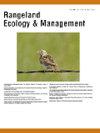Impact of Wildlife Grazing During Drought on Herbaceous Vegetation in a Semiarid Rangeland and Postdrought Recovery
IF 2.4
3区 环境科学与生态学
Q2 ECOLOGY
引用次数: 0
Abstract
Rainfall is regarded as the primary determinant of vegetation dynamics in non-equilibrium semi-arid rangelands and mitigates the potential impacts of heavy grazing. In reality, the impact of grazing and rainfall on vegetation dynamics in these systems are far more complex. It is well documented that the combined effect of heavy grazing and drought conditions in semi-arid rangelands can be particularly impactful on herbaceous vegetation. In Witsand Nature Reserve, located in the southern Kalahari, vegetation was subjected to heavy grazing by wild herbivores (game species) for prolonged periods. The region also experienced the most severe drought recorded in the region in the last 60 years. A study was conducted to determine the extent that heavy grazing impacted the response of vegetation to rainfall variability. Furthermore, the applicability of non-equilibrium based models in this semi-arid rangeland was tested. The study also investigated the effects of heavy grazing by wildlife and compared it to the reported detrimental effects of overgrazing caused by livestock. The results found that rainfall was the main determinant of cover abundance and biomass changes, but did not affect species composition. Heavy grazing resulted in areas of low species diversity and the dominance of undesired annuals. Heavily grazed areas were also far more susceptible to drought conditions compared to lightly grazed areas. In lightly grazed areas, vegetation responses post-drought conformed to the description of non-equilibrium systems while heavily grazed sites did not. This was indicative of vegetation responses being closely coupled to the inherent resilience of the vegetation. Heavy grazing by wildlife resulted in the degraded state of the rangelands, as has also been found with livestock farming. The key difference of overgrazing caused by livestock and wildlife was concluded to be in the spatial extend of the impact. This is due to the management and behavioural differences between livestock and wildlife.
干旱期野生动物放牧对半干旱草原草本植被的影响及干旱后恢复
降雨被认为是非平衡半干旱草地植被动态的主要决定因素,可以缓解重度放牧的潜在影响。实际上,放牧和降雨对这些系统中植被动态的影响要复杂得多。有充分的文献证明,在半干旱的牧场上,重度放牧和干旱条件的综合影响对草本植被的影响尤其大。在位于喀拉哈里沙漠南部的Witsand自然保护区,植被长期受到野生食草动物(狩猎物种)的大量放牧。该地区还经历了过去60年来有记录以来最严重的干旱。研究了重度放牧对植被对降雨变率的影响程度。进一步验证了非平衡模型在半干旱草原的适用性。该研究还调查了野生动物过度放牧的影响,并将其与牲畜过度放牧造成的有害影响进行了比较。结果发现,降雨是覆盖丰度和生物量变化的主要决定因素,但不影响物种组成。过度放牧导致该地区物种多样性低,不需要的一年生植物占主导地位。与轻度放牧地区相比,重度放牧地区也更容易受到干旱的影响。在轻度放牧地区,干旱后植被响应符合非平衡系统的描述,而重度放牧地区则不符合。这表明植被的响应与植被的内在恢复力密切相关。野生动物的过度放牧导致了牧场的退化,畜牧业也是如此。畜禽过度放牧与野生动物过度放牧的主要区别在于影响的空间延伸。这是由于牲畜和野生动物之间的管理和行为差异造成的。
本文章由计算机程序翻译,如有差异,请以英文原文为准。
求助全文
约1分钟内获得全文
求助全文
来源期刊

Rangeland Ecology & Management
农林科学-环境科学
CiteScore
4.60
自引率
13.00%
发文量
87
审稿时长
12-24 weeks
期刊介绍:
Rangeland Ecology & Management publishes all topics-including ecology, management, socioeconomic and policy-pertaining to global rangelands. The journal''s mission is to inform academics, ecosystem managers and policy makers of science-based information to promote sound rangeland stewardship. Author submissions are published in five manuscript categories: original research papers, high-profile forum topics, concept syntheses, as well as research and technical notes.
Rangelands represent approximately 50% of the Earth''s land area and provision multiple ecosystem services for large human populations. This expansive and diverse land area functions as coupled human-ecological systems. Knowledge of both social and biophysical system components and their interactions represent the foundation for informed rangeland stewardship. Rangeland Ecology & Management uniquely integrates information from multiple system components to address current and pending challenges confronting global rangelands.
 求助内容:
求助内容: 应助结果提醒方式:
应助结果提醒方式:


